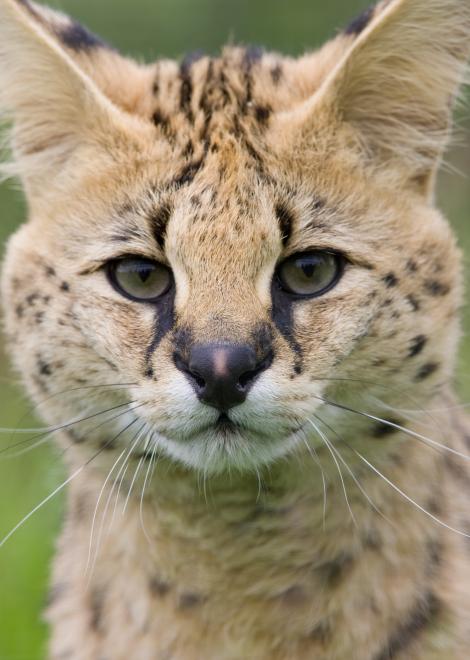
There are fewer servals now than ever before due to the human population taking over its habitat and hunting for its pelt. It is not an endangered species at the present time; however, it may come to that unless the fur trade becomes better controlled.
Interesting facts
Did you know that servals are the most easily tamed of all wild cats? The Egyptians kept them as pets and used them to catch rodents.
Did you know that even though servals seldom swim, they are good swimmers?
Hunting and Diet
Although the serval is highly respected for its ability to catch rodents, it is also an opportunistic predator whose diet also includes hares, hyraxes, birds (quails, flamingos, quelea and teal), reptiles, insects, fish and frogs. The serval may occasionally take an antelope or larger animal, but more often, the serval's prey will weigh less than 7 ounces.
The Serval's long legs aid the animal to be able to rise above the tall savannah grass when hunting prey. The Serval also uses it's long legs to leap into the air and pounce on it's prey, much like a fox. Also like a fox, the Serval's large ears give it an incredible hearing, allowing it to hear small animals moving through the tall grass ; the feline can perfectly locate prey without even seeing it.
The Serval's diet consists of small mammals, birds, reptiles, amphibians, insects ; and even fish which it scoops out of the water with it's long forelimbs. The forelimbs are also used when catching birds out of the air when the cat leaps up and claps the prey item with it's front paws ; and also when reaching into burrows. It is an efficient predator with a 50% success rate, and rarely eats carrion.
The serval is in danger of becoming extinct due to humans taking over its habitat
Habitat and Range
The serval's main habitat is the savannah. It also lives in the dry open grasslands and in the moister areas around the equatorial rainforests. Because the serval needs water courses within its territory, it does not live in semi-deserts. Although it is able to climb and swim, it seldom does so.
Inhabiting more than 35 countries, the Serval is native to the African continent, prefering savannah, reed beds, moorland, bamboo thickets, and habitats with tall grass and bush , near to a water source. Though this cat has a large range throughout sub-Sahara Africa, it has not been observed to inhabit central, equatorial Africa, or the Southern part of the continent. It is also not common in the Sahara.
Conservation Status
Being an abundant species of wild cat, the Serval is considered by the IUCN to be Least Concern, with 19 subspecies ; however it is still under threat of poaching for it's skin which is often marketed as leopard or cheetah on the black market ; and also for it's flesh, which is considered a delicacy by local tribes. Confrontation with humans has resulted in this feline avoiding heavily populated areas as it's taste for captive poultry leads it to be targeted by hunters.
Another very serious threat is habitat destruction, by human developments as well as annual fires.
Social Behaviour and Reproduction
The Serval is a solitary cat, only coming together during the breeding season, in which the male and female stay together for only a few days. The female's gestation is 65 – 75 days, after which she gives birth to 2 – 4 kittens, which she raises alone until they reach sexual maturity. The kittens are difficult to observe in the wild as the mother often hides them very well while she hunts.
Servals reach sexual maturity at 18 – 24 months, and have been known to reach up to 19 years old in captivity.
Size and Appearance
Being larger than a domestic cat, the Serval is 60cm in length ; 50cm at the shoulder ; and weighs 9 – 18 kilograms. It is a medium-sized feline with tawny fur spattered with black spots ; it has long legs for seeing over the long savannah grass, and large, mobile ears with acute hearing. The tail is relatively short, and the neck is longer than most cats.
They are said to resemble a smaller version of the Cheetah ; with the longest legs per body size of any feline.